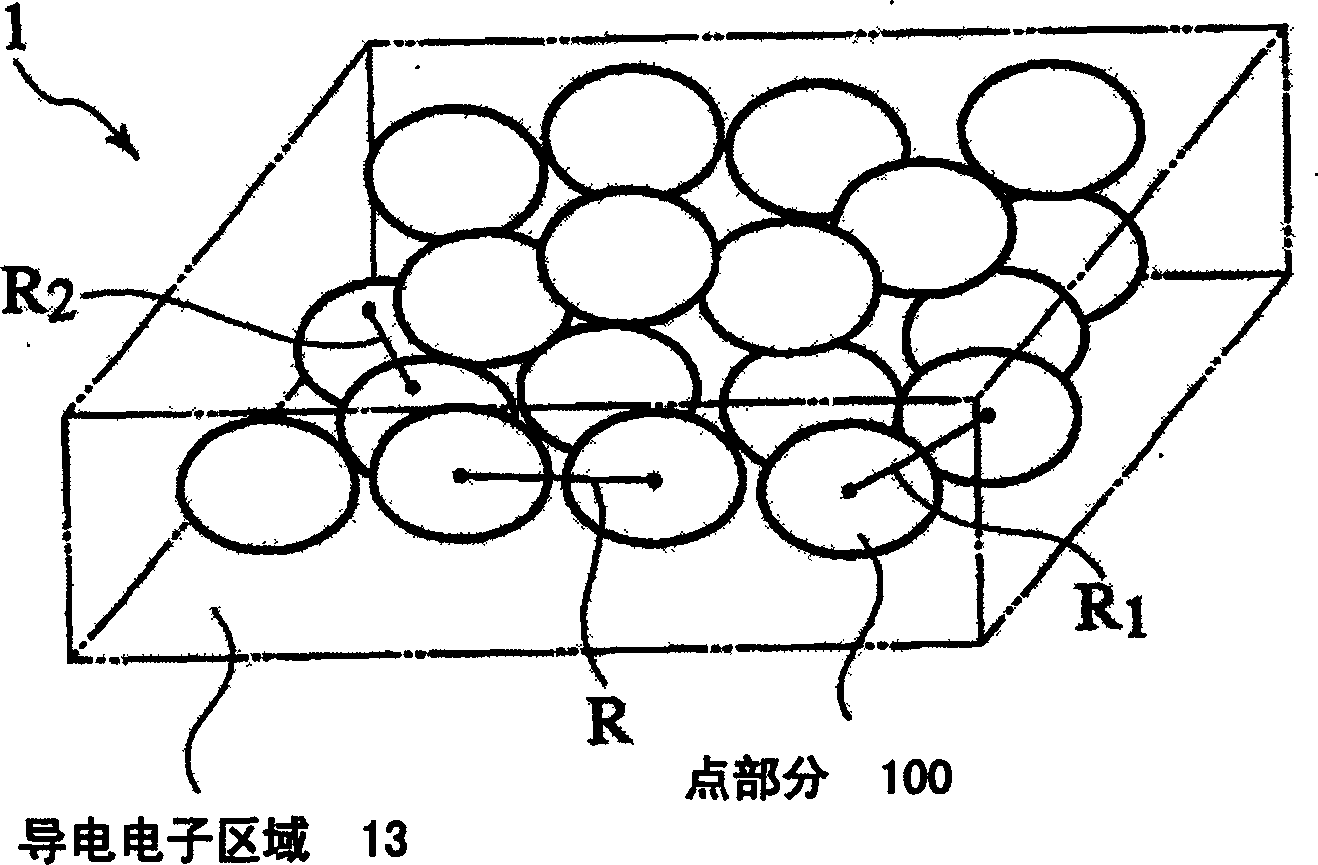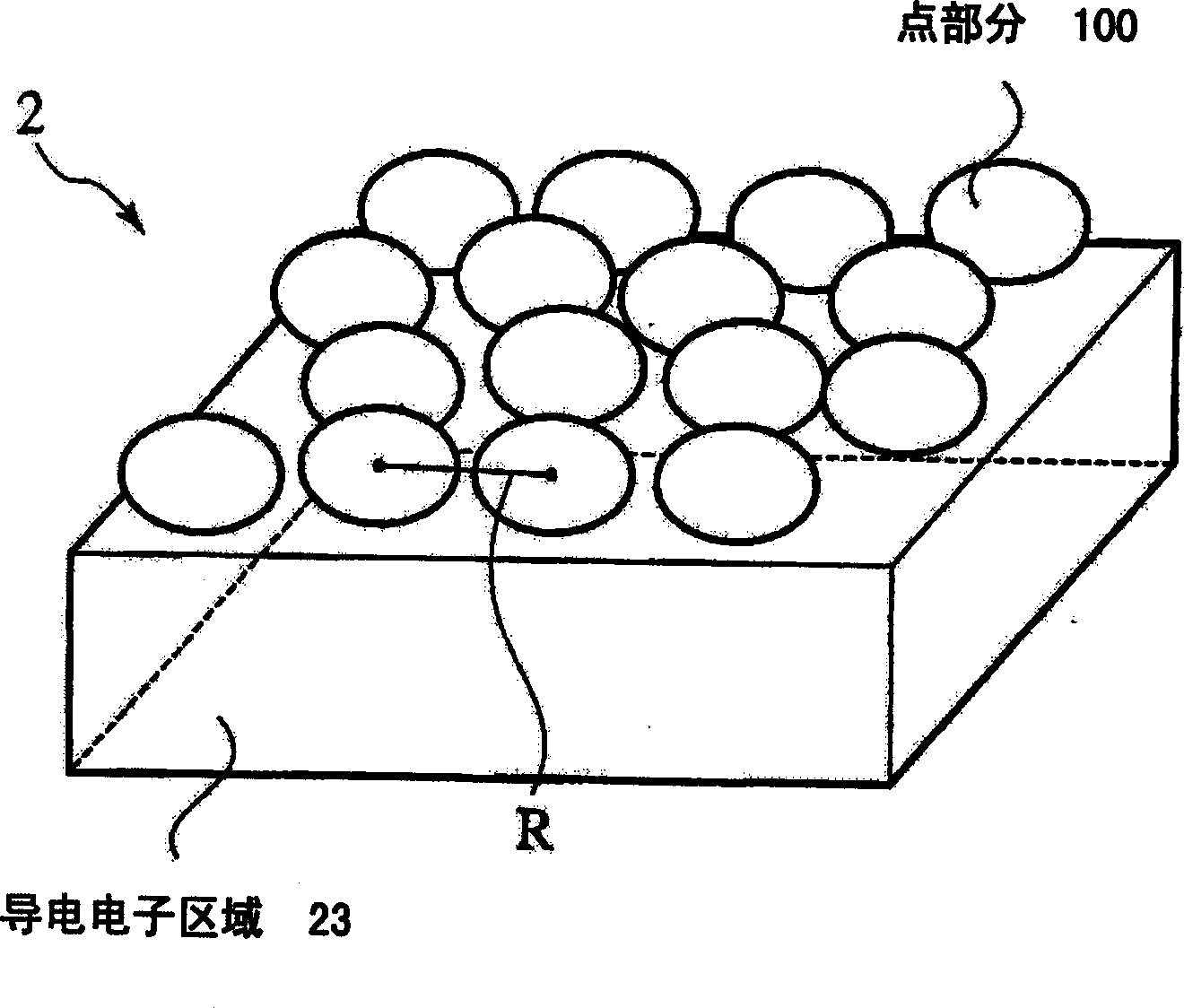Magnetic body, apparatus using the same and its mfg. method
A magnet and non-magnetic technology, applied in the direction of inductance/transformer/magnet manufacturing, magnetic objects, magnetic materials, etc., can solve the problems of poor bonding ability of adjacent substances, miniaturization, high integration, and reduction of circuit production steps. Problems such as making magnetic substances
- Summary
- Abstract
- Description
- Claims
- Application Information
AI Technical Summary
Problems solved by technology
Method used
Image
Examples
no. 1 example
[0114] figure 1 Shown is an explanatory diagram of the magnet structure of the first embodiment of the present invention. in addition, figure 2 shown as figure 1 Illustrative diagrams of the structure of one point part 100, as shown in these figures, the magnet 1 has the structure of multi-quantum dots 11, and the multi-quantum dots 11 form local electron regions with local spins, wherein at least one electron is confined, and the multi-quantum dots 11 overlap each other at the dot portion 100, surrounded by a barrier layer 12 (barrier potential region), electrons pass through the barrier layer and are confined within each quantum dot 11, in a conduction electron region 13, consisting of a conduction electron system, which The energy is less than that of the barrier layer 12 .
[0115] At the same time, there is no contrary opinion that the energy magnitude of the quantum dot 11 in the electron localized region and the conduction electron region 13 is an arbitrary value. ...
no. 2 example
[0142] Figure 6 Shown is an explanatory diagram of a magnet structure of a second embodiment of the present invention. Figure 6 The illustrated magnet 5 attempts to use a two-dimensional conducting electron gas that forms in the two-dimensional electron system interface 56, such as compound semiconductors composed of GaAs, aluminum-cadmium-selenium (AlGaAs), and silicon and silicon oxides. Different interfaces for the commutation layer of silicon MOS (Metal Oxide Semiconductor) transistors.
[0143] However, Figure 6 Shown at the boundary between the semiconductor 54 and the semiconductor 55, a two-dimensional electronic system interface 56 is formed, in one case, the two-dimensional electronic system interface 56 includes different interfaces of the above-mentioned semiconductor compound, the semiconductor 54 is composed of GaAs, the semiconductor 55 (insulating layer) is composed of AlGaAs. In this case, GaAs and AlGaAs can also be reversed. It is also possible, in a ...
no. 3 example
[0151] Figure 8 Shown is an explanatory diagram of a magnet structure of a third embodiment of the present invention. The magnet 6 shown in the figure is manufactured by an etching method or a semiconductor selective growth method. In particular, by etching, a semiconductor is processed to remove a portion of it to eventually form Figure 8 The structure shown, by means of which the electrodes transport allows the accumulation of the electrodes within this wire domain of quantum, the cross-section of this wire area represented in the same figure by the particular rhombus shape, thus forming the quantum dot portion 61 . At the same time, the size of the quantum dot portion 61 is also equal to the size of the quantum dot portion of the first embodiment and the second embodiment. In addition, in Figure 8 In , all the cross-sectional areas forming the quantum dot portion 61 are shown and described in the same rhombus shape. Of course, it can be understood that the quantum do...
PUM
| Property | Measurement | Unit |
|---|---|---|
| thickness | aaaaa | aaaaa |
Abstract
Description
Claims
Application Information
 Login to View More
Login to View More - R&D
- Intellectual Property
- Life Sciences
- Materials
- Tech Scout
- Unparalleled Data Quality
- Higher Quality Content
- 60% Fewer Hallucinations
Browse by: Latest US Patents, China's latest patents, Technical Efficacy Thesaurus, Application Domain, Technology Topic, Popular Technical Reports.
© 2025 PatSnap. All rights reserved.Legal|Privacy policy|Modern Slavery Act Transparency Statement|Sitemap|About US| Contact US: help@patsnap.com



